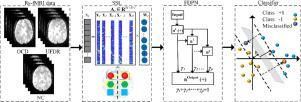Medical Image Analysis ( IF 10.7 ) Pub Date : 2021-09-29 , DOI: 10.1016/j.media.2021.102244 Peng Yang 1 , Cheng Zhao 1 , Qiong Yang 2 , Zhen Wei 3 , Xiaohua Xiao 4 , Li Shen 5 , Tianfu Wang 1 , Baiying Lei 1 , Ziwen Peng 6

|
Obsessive-compulsive disorder (OCD) is a type of hereditary mental illness, which seriously affect the normal life of the patients. Sparse learning has been widely used in detecting brain diseases objectively by removing redundant information and retaining monitor valuable biological characteristics from the brain functional connectivity network (BFCN). However, most existing methods ignore the relationship between brain regions in each subject. To solve this problem, this paper proposes a spatial similarity-aware learning (SSL) model to build BFCNs. Specifically, we embrace the spatial relationship between adjacent or bilaterally symmetric brain regions via a smoothing regularization term in the model. We develop a novel fused deep polynomial network (FDPN) model to further learn the powerful information and attempt to solve the problem of curse of dimensionality using BFCN features. In the FDPN model, we stack a multi-layer deep polynomial network (DPN) and integrate the features from multiple output layers via the weighting mechanism. In this way, the FDPN method not only can identify the high-level informative features of BFCN but also can solve the problem of curse of dimensionality. A novel framework is proposed to detect OCD and unaffected first-degree relatives (UFDRs), which combines deep learning and traditional machine learning methods. We validate our algorithm in the resting-state functional magnetic resonance imaging (rs-fMRI) dataset collected by the local hospital and achieve promising performance.
中文翻译:

基于空间相似性感知学习和融合深度多项式网络的强迫症诊断
强迫症(OCD)是一种遗传性精神疾病,严重影响患者的正常生活。稀疏学习通过从脑功能连接网络(BFCN)中去除冗余信息并保留监测有价值的生物学特征,已被广泛用于客观地检测脑部疾病。然而,大多数现有方法都忽略了每个受试者大脑区域之间的关系。为了解决这个问题,本文提出了一种空间相似性感知学习(SSL)模型来构建BFCN。具体来说,我们通过模型中的平滑正则化项来包含相邻或双边对称大脑区域之间的空间关系。我们开发了一种新的融合深度多项式网络 (FDPN) 模型,以进一步学习强大的信息,并尝试使用 BFCN 特征解决维数灾难问题。在 FDPN 模型中,我们堆叠了一个多层深度多项式网络 (DPN),并通过加权机制整合了来自多个输出层的特征。这样,FDPN方法不仅可以识别BFCN的高级信息特征,还可以解决维数灾难问题。提出了一种新的框架来检测强迫症和未受影响的一级亲属(UFDR),该框架结合了深度学习和传统的机器学习方法。我们在当地医院收集的静息状态功能磁共振成像 (rs-fMRI) 数据集中验证了我们的算法,并取得了可喜的性能。










































 京公网安备 11010802027423号
京公网安备 11010802027423号